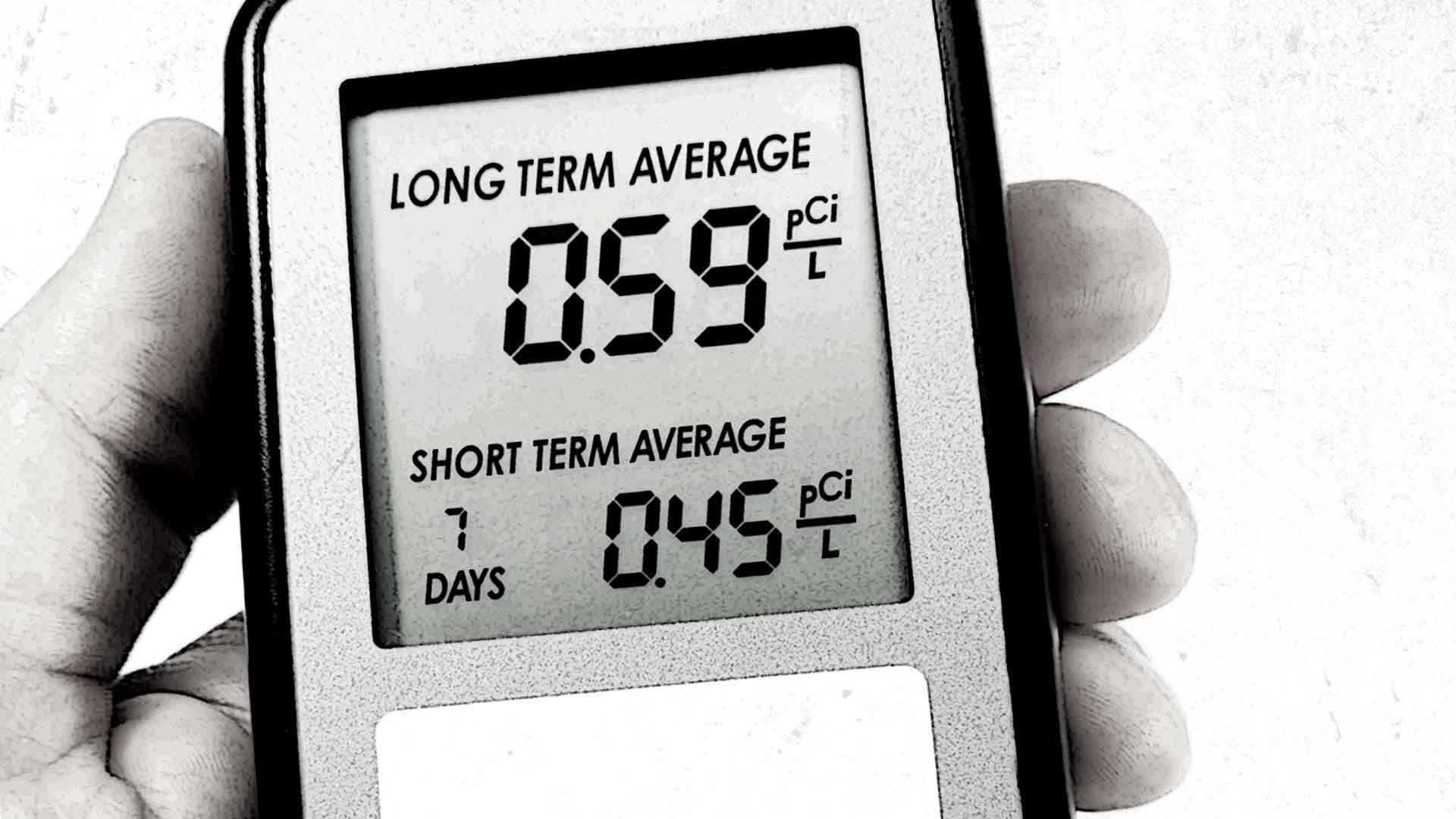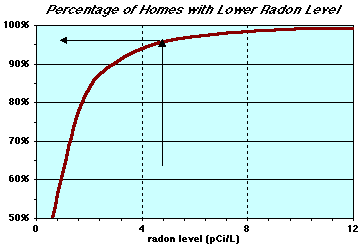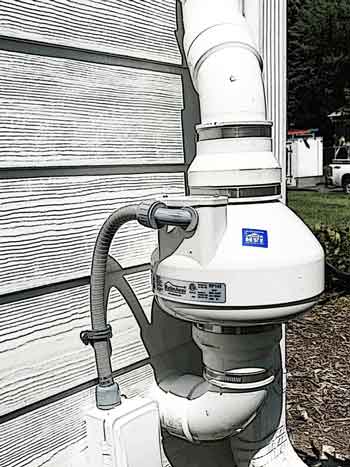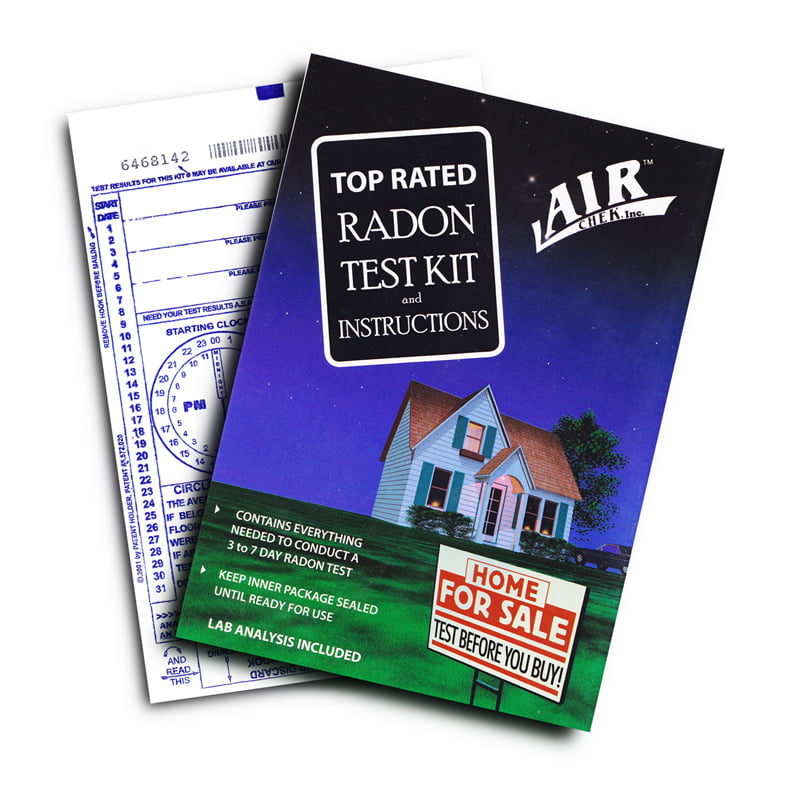
Radon Levels in U.S. Homes
It is difficult for people to accept that their home, a place that one looks to for security, is hiding invisible danger. Yet, the average person receives a higher radiation dose from radon at home than from all other natural or man-made sources combined.
Outdoor radon levels in the U.S. range from 0.02 to 0.75 pCi/L (picoCuries per liter), averaging 0.4 pCi/L. But homes draw concentrated radon gas from the ground. Because radon is nine times heavier than air, elevated radon levels build up in basements and on lower floors. Although the U.S. Congress has set the natural radon concentration outdoors as the target level for homes, approximately two-thirds of homes exceed it. Half of American homes have a radon level above 0.67 pCi/L (the median level). The average (mean) radon level in US homes is 1.25 pCi/L, or three times higher than the average level outdoors. How Radon Sneaks Into Homes
Nearly 8 million US homes, or 1 out of every 15, have radon levels above the EPA’s 4 pCi/L “action” limit, and nearly 1 out of 6 exceed the EPA’s 2 pCi/L “consider action” limit. You should always try to reduce radon to a practical minimum – if you just settle for 4 pCi/L, your home will be more radioactive than 94% of US homes.
What are “PicoCuries”?
he concentration of radon gas is not measured directly but rather by the radioactivity it produces. It is expressed in picoCuries per liter of air, or “pCi/L”. A Curie is a unit of radioactivity equivalent to 1 gram of radium and the prefix “pico” means a trillionth. In the metric system, radon concentration is expressed in Becquerels per cubic meter (Bq/m3). One Becquerel means one radioactive disintegration per second, and 4 pCi/L equals to 148 Bq/m3. In an average basement, 38 million atoms will undergo radioactive decay each hour.

How About All the Other Radiation Around Us?
Background radiation levels are a combination of terrestrial (radium, thorium, radon, etc.) and cosmic radiation (photons, muons, etc.) Natural radioactivity is common in the rocks and soil that make up our planet – over 60 radionuclides (radioactive elements) can be found in nature.
Sunshine is radiation. The visible light is in the middle of its range of wavelengths. The long-wave radiation is infrared and it warms the skin. The shortest wavelength is ultraviolet radiation which causes skin cancer.
Beyond the ultraviolet radiation is higher-frequency radiation emitted from nuclei of unstable radioactive atoms – ionizing radiation. It has enough power to knock out electrons from atoms and convert them to electrically charged ions, which can damage the large molecules of living cells. Ionizing radiation damages DNA and just one mutant cell can cause cancer. There are several types of ionizing radiation:
- Alpha particles consist of two protons and two neutrons (like the nucleus of helium) and can pack a microscopic wallop when they collide with molecules. Because of their relatively large size, alpha particles collide readily with matter and therefore do not penetrate deep. Because they give up their energy over a relatively short distance, alpha particles can inflict more biological damage than any other radiation.
- Beta particles are fast-moving electrons (or even the anti-matter positrons) ejected from the nuclei of atoms. Being much smaller than alpha particles, they can penetrate up to 1 to 2 centimeters of water or human flesh.
- X-rays and gamma rays are pure energy transmitted in a wave without the movement of matter, just as light photons. But unlike light, they have great penetrating power and easily pass through the human body. Gamma rays emitted from nuclei are similar to X-rays but more energetic.
Radon decay chain offers a full menu of ionizing radiation: alpha and beta particles, and gamma rays. (Nuclear explosions emit one more radiation – neutrons.) Cosmic radiation consists of a variety of very energetic particles, including protons, muons, and neutrinos, which bombard the earth from outer space. Radioactivity is all around us, as well as within us. Radon Gas Is All Around Us
However, two-thirds of the total effective radiation dose to the average American from all-natural sources comes from radon and its progeny. Radon in homes is more concentrated and far more dangerous than outdoors – the National Academy of Sciences estimates that the outdoor radon causes only 800 out of the total of 21,000 lung cancer deaths caused by radon in the US each year.
Official Limits on Radon Levels
Although radon in homes has been declared a national health problem, there are no federal or state standards. The Radon Act 51 passed by the US Congress set the natural outdoor level which averages 0.4 pCi/L as the target radon level for homes which unfortunately most homes (two-thirds) exceed.
The Environment Protection Agency was given the task of developing practical guidelines. Considering the high cost of mitigation methods available to homeowners in the 1980s (averaging $1,200 but up to $2,500), EPA issued its recommendations:
- 4 pCi/L … the “action” limit (fix your home)
- 2 pCi/L … the “consider action” limit (consider fixing your home)
EPA did not want to force homeowners to install costly radon mitigation systems, leaving the decision up to each homeowner. But at the same time, EPA has made it clear that the 4 pCi/L action limit is not a “safe” level and warned the public:
Any radon exposure has some risk of causing lung cancer. The lower the radon level in your home, the lower your family’s risk of lung cancer.
Unlike radon levels in homes, occupational radon limits are governed by law and regulations. The Miners Safety and Health Act (MSHA) covers underground miners. Their annual exposure is limited to less than 4 WLM (Working Level Months), equivalent to 33 pCi/L during their working hours. The Occupational Safety and Health Act (OSHA) limits cumulative radon exposure in the workplace to 30 pCi/L based on 40 working hours per week. Assuming the highest radon level in modern mines, the average person receives in his home at 4 pCi/L over 12 years the same radiation dose as if he/she worked for 5 years in a uranium mine.

Action Limit is Not a Safety Limit
“Action limit” does not imply safety. It is merely the result of a macroeconomic cost/benefit analysis for the US population at large. Shockingly, the cancer risk from radon at the “action” limit is about 1,000-times higher than the safety limits allowed for suspected carcinogens and toxins in food or drinking water.
The societal cost of mitigating all homes to a 4 pCi/L level was estimated at $44 billion but that would rise to $101 billion if the action level was set at 2 pCi/L. Most radon-attributed deaths (70%) are caused by radon levels lower than 4 pCi/L (BEIR VI, 1998). Setting the limit at 4 pCi/L benefits (but does not necessarily save) only 30% of the 21,000 people that die each year of radon-attributed lung cancer, while a lower limit of 2 pCi/L would benefit 50%. The high “action limit” reduces the number of lives saved.
And, the societal cost of lung cancer deaths caused by radon is relatively low because it kills so quickly, often within months. Its 5-year survival rate is only 10–14 percent and thus, it costs only several billion dollars per year. Spending money, for example, on an anti-smoking campaign saves more lives, even though it is unfair to non-smokers and children who may be exposed to radon gas. (Radon causes 26% of lung cancer deaths among non-smokers.)
The “action” limit is based on the average cost of a radon mitigation system in the 1980s – $1,200. If the cost of radon mitigation was only $600, the action limit recommended to homeowners would have been set at 2 pCi/L.
How Safe is the 4 pCi/L Radon Action Limit?
People spend most of their time at home – on average 70%, but more in case of women and particularly, children. Although the 4 pCi/L level has become a benchmark for real estate transactions, it still carries considerable risks – equivalent to getting a chest x-ray or smoking 10 cigarettes each day. (EPA)
When relaxing at home, we breathe in radon. It is soluble in blood and circulates through the body and all organs. Some tends to accumulate in fatty issues. Then, almost all is harmlessly exhaled by our lungs or skin until equilibrium is established between the ambient and internal radon concentrations.
But radon decay products, radioactive solid particles, much smaller than household dust, float in the air and get trapped in our lungs, trachea, and bronchi. At 4 pCi/L each liter of air contains 70,000 radon atoms. But less than 1% of the inhaled atoms get trapped and we thus accumulate in our airways about 600,000 radioactive particles every hour. When they shoot out alpha particles, they damage the DNA of epithelial cells, causing mutations and lung cancer.
The risk to the average person of dying of radon-caused lung cancer due to a lifetime exposure to 4 pCi/L radon level at home is 2.3 percent. If there are five people in your family, the chances that someone becomes a victim of radon over 10 percent.
The most substantial epidemiological study ever on the link between residential radon and lung cancer was published the University of Iowa in 2003. This 5-year study proves that radon even at the low levels found in homes causes lung cancer and that the risk is proportional to the radon level. The study shows that the exposure of adult women to radon over 15 years at the EPA “action” level of 4 pCi/L increases the lung cancer risk by 50 percent.
Are Short-Term Radon Test Kits Useful?
Short-term radon measurements are often off by more than a factor of 2 different compared to the real long-term average, and sometimes more than a factor of 4 different. They are not a sound basis for radon mitigation decisions. For more info visit short-term vs. long-term radon test kits.
Lower Limits on Radon in the Near Future?
In 2009, the World Health Organization set a new recommended radon reference level of 2.7 pCi/L for residential structures.
The President’s Cancer Panel issued its “Reducing Environmental Cancer Risk: What We Can Do Now” in 2010. It encourages the EPA to consider lowering its current “action level” (the level at which remedial action is recommended) of 4 pCi/L for radon exposure, given that new radon risk data have emerged since the existing action level was set.
